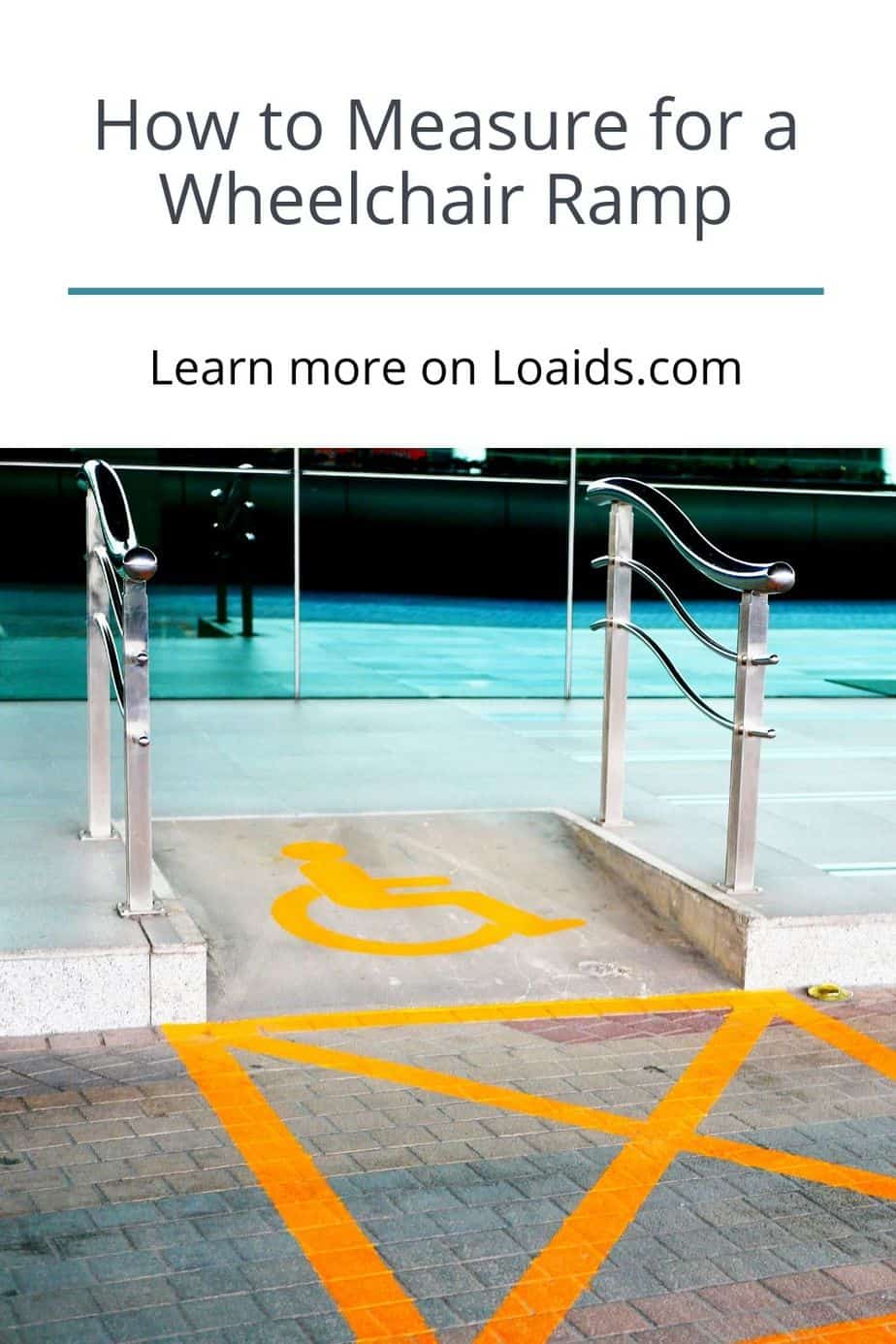What length of wheelchair ramp do I need?
If you’re planning to install a wheelchair ramp in your home, that’s something you definitely need to know!
This article will cover all you need to know in order to get the job done perfectly!
We’ll also go over some important tips for measuring your wheelchair ramp, so let’s get started!
READ MORE: Who Invented the Wheelchair Ramp?
Table of Contents
How Long Should a Wheelchair Ramp Be?
To get started with the task, the most critical question is: what length wheelchair ramp do I need?
Wheelchair ramp length is one of the most important factors to determine when deciding on placing a ramp. This is because it can affect a person’s safety, ease of use, and convenience.
Also READ: How Wide Does a Wheelchair Ramp Need to Be?
ADA Recommended Measurements for Wheelchair Ramps
The Americans with Disabilities Act (ADA) stipulates that ramps for commercial or public usage must have a 1:12 ratio. The outdoor wheelchair ramp slopes should be 12 inches long for every inch of slope or elevation.
For instance, a wheelchair ramp for a 24″ rise requires a minimum ramp length of 24′. This enables a low 5-degree incline for convenience and safety.
Moreover, a slope ratio of 1:8 is appropriate for shorter ramps. Consequently, for a vertical rise of 1.5 inches, the wheelchair ramp must be a foot long.
Apart from that, a 2:12 slope ratio is used in most residential ramps with limited space or area. This is recommended for wheelchair users who want to be able to climb up without assistance.
Furthermore, a 3:12 slope is an excellent ratio to follow for those without residents who use wheelchairs.
Other recommended maximum slope ramp degrees include a 7-degree angle for users who can use the ramp independently or with light help, 10-degrees for users who require moderate support, and a 12-degree angle for users with powerful electric wheelchairs or scooters, or for those who need strong assistance.
The wheelchair ramp angle should be 1″ of rise for every 12″ of length for straight ramps.
Similarly, if you’re looking to build or buy a wheelchair ramp length for 3 steps, consider that ADA recommends 1 foot of a ramp for every inch of rise.
Also Read: How to Build Ramp for Wheelchair Over Steps?
For demonstration, check this video:
READ MORE: How Much Are Handicamp Ramps?
How to Measure for a Wheelchair Ramp
To determine the ramp length, you must first establish the measurements required for the steps to which the ramp will be attached.
The total vertical rise is the distance between the bottom of the steps to the top of the stairwell. The horizontal distance between the top of the steps and the bottom of the ramp is measured without obstructions.
Finally, the wheelchair ramp slopes are measured diagonally from the top of the steps to the floor where the wheelchair ramp ends.
If you’re building a wheelchair ramp, however, you must also consider the measurement of the handrails on either side of the ramp segment.
Calculate the Wheelchair Ramp Length for Various Rises
It is critical to determine the height of the rise you want to climb.
To do so, calculate the total time by adding the height of each step from the bottom to the top of the stairwell.
Then, for your intended purpose, divide this value by your slope.
Furthermore, the ADA mandates a level landing at both the bottom and top of the ramp, so you’ll need to take exact measurements for that as well.
On top of that, you’ll need to calculate the ramp surface to know where it meets the ground surface.
For this purpose, you can also use a ramp slope calculator and get precise measurements for the minimum ramp surface.
Whether the wheelchair ramp is for residential or commercial usage, you must consider the ease of the ramp’s different users.
The ideal ramp isn’t prone to hazards, especially for your loved ones’ protection.
4 Tips For Measuring Your Wheelchair Ramp
#1 Use a Sturdy, Flat, and Precise Measuring Tool
You can’t use a measuring instrument that has trouble measuring the floor with precision. Because of its flimsiness and length, a measuring tape is not an appropriate tool for measuring ramps.
You should use a reliable and excellent tool like a standardized industrial steel tape measure for precise measurements.
#2 Take Down the Measurements in a Notepad
You can’t expect to remember all of the measurements and calculations in your head.
To guarantee precise results, write down the measurements on a piece of paper, a notepad, or your phone.
#3 Have a Partner to Hold You Accountable
When you don’t know what you’re doing, don’t be hesitant to ask for help. It might be good to have someone else double-check your measurements, values, and processes to make an ADA-compliant ramp.
It would also be easier to verify the minimum ramp size after your calculations, allowing you to visualize the placement of the ramp in its designated space.
#4 The Biggest Mistake to Avoid
When calculating the length of a wheelchair ramp, the slope ratio to achieve the recommended length is only valid for measurements with the same unit.
For example, you can’t divide the sum of steps with its unit in inches with the vertical height of the staircase measured in meters.
In this instance, the ratio would be inaccurate, and you may end up spending time, effort, and money on a wheelchair ramp that is eventually inefficient or useless.
Therefore, you must decide on one unit of measurement and not switch to another while computing for the length you want.
As a result, you will be able to get a safe wheelchair ramp without compromising on quality or convenience.
For more info, check the video below:
Frequently Asked Questions
How do you measure for a wheelchair ramp?
Measure the total vertical rise (from the floor to the top of the steps), the horizontal distance without obstruction between the top of the stairs and ground level, and the ramp length (diagonal distance, instead of previously said horizontal one).
What is the best angle for a ramp?
It all depends on how you want to utilize the ramp. According to ADA guidelines for ramps, commercial ramps should have a 1:12 ramp slope ratio, whereas residential ramps can have a ratio of 2:12 or 3:12.
To make your decision, consider how the wheelchair ramp will fulfill the needs of the users. This will also help you choose between aluminum ramps, wooden ramps, or concrete ramps.
What size ramp for a wheelchair do I need?
When wondering how to size a wheelchair ramp, calculate the total rise and determine the slope rise you’ll need. Then, divide the inch rise by the slope to get the minimum ramp length.
You can use the recommended ratios as a reference to determine which slope is best. Moreover, try out a ramp slope calculator to gather precise measurements and avoid any errors.
What unit of measurement should you use for measuring a wheelchair ramp?
For a small number of steps, it’s best to measure everything in inches until you’ve calculated the ramp length. You cannot change measurements before computing; however, you can consider changing the unit to simpler ones only once you have the correct value.
Conclusion
All sites have various entryways, but regardless of whether in a private or public space, the wheelchair ramp length should be appropriate for the people who may use it.
When determining the ideal length for a wheelchair ramp, comfort and safety must take precedence over aesthetics and the space used.
References:
- Burfield, John. 2017. “How Long Should a Wheelchair Ramp Be?” Lifewaymobility.com. Main Site. October 5, 2017. https://www.lifewaymobility.com/blog/how-long-should-a-wheelchair-ramp-be/.
- Express Ramps, LLC. 2021. “ADA Guidelines, ADA Ramp Slope, ADA Compliant Handicap Ramp Code Slope.” Adawheelchairramps.com. 2021. https://www.adawheelchairramps.com/wheelchair-ramps/ada-guidelines.aspx#:~:text=%20The%20Americans%20with%20Disabilities%20Act%20%28ADA%20Guidelines%29,36%20inches%20of%20clear%20space%20across…%20More%20.
- “Handicap Ramp Slope, Handrail, and Landing Requirements.” The Balance Small Business. 2020. https://www.thebalancesmb.com/ada-ramp-construction-844440.
- “Ramp Calculator | Roll-A-Ramp®.” 2018. Roll-A-Ramp. October 15, 2018. https://www.rollaramp.com/ramp-calculator/.
- “‘What Length Ramp Should I Order for 3 Stairs?’ | HandiRamp.” 2015. Handiramp.com. December 22, 2015. https://handiramp.com/blog/what-length-ramp-should-i-order-for-3-stairs/.

What are your thoughts on the wheelchair ramp length? Share with us below!





I was on a very steep ramp at the Visitor’s Center at Colonial Williamsburg, the facility at the shore of the Atlantic, not the more extensive city to the west. A lady in a wheelchair was struggling to push her chair up-ramp, and could not maintain progress, and stalled, and worse, her right hand slipped, she got turned at an angle (making a clock-wise turn ON the ramp) and I saw she might be slipping backwards into the side of the ramp, a vertical wall.
She COULD HAVE hit the wall of the ramp, ON HER LEFT SIDE, while her hands slipping on the wheel rim grip, SLIPPING backwards, and possibly lose control totally, and roll backwards into the other visitors WAITING in line, INCLUDING CHILDREN, all going up, OR even tip over while rolling backwards. A very dismal situation.
I was not in a position to easily climb over the elevated rail, and assist, so I tried to signal the only available other man (with wife and kids) to try to help her, but he was too timid to intervene.
Somehow the lady was able to summon her strength and continue pushing herself upward, and reach the ground-level of the store, and the parking lot. I was astonished at her determination.
I have, totally coincidentally, about six female friends with obvious disabilities, including Polio, spinal cord injury, MS, and even double leg amputations due to diabetes.
I therefore have been very familiar with wheelchair use, and have seen cases of inexperienced women voluntarily TRYING to assist friends with simple SIDEWALK CURBS to cross, and WORSE, not being able to keep the chair in control on a straight stairway.
NEVER approach a stairway with a wheelchair turned at ANY small angle. ONE wheel being off-position will overturn the chair! This is dangerous! No wonder wheelchair users get panicky when strangers insistently volunteer to “Help”.